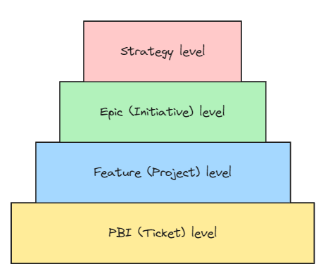Levels of work
All types of work are equal, but some are more equal than others.

In the organisation that I work at right now (~50 engineers) there is more work to do than just coding. There’s work, there’s meta-work, and there’s meta-meta work. In this post I want to talk about the invisible work hierarchy that makes some work more equal than other work.
I like to visualise the work hierarchy as a pyramid where each level builds on top of the previous level. Working from bottom to top we have:
-
PBI (Ticket) level: At the bottom of the pyramid we have the actual “work” work. This is the base level involving direct implementation and coding work on individual items (Product Backlog Items (PBIs) or tickets) from the product backlog. Every level of engineer handles this kind of work, but this is specifically where you start as a junior engineer, working on specific tasks with clear outcomes. Timeframe: Days/weeks.
-
Feature (Project) level: The level above the PBI (Ticket) level is the Feature (Project) level. This level involves a collection of PBIs, forming a feature or a small project. This level requires you to define, shape, and refine the project as a larger whole and the tickets below: What is this project? When is it done? What is the critical path? What pieces can we sequence or do in parallel? Work here is suitable for junior engineers looking to grow and expected work for mid-level engineers. Timeframe: Weeks/months.
-
Epic (Initiative) level: The level above the Feature (Project) level is the Epic (Initiative) level. An epic is a collection of features, representing a series of high-level projects. This level involves a structured planning process discussing the benefits, costs, and impacts on various fronts (teams, customers, business, legacy, users, and development teams). Senior engineers and team leaders often handle this level. Final decisions come from high-level management (CEO, CTO). Timeframe: Quarters/years.
-
Strategy level: The final level is the level above the Epic (Initiative) level. This level involves influencing high-level decision-makers (CEO, CTO) to prioritise specific epics. Successfully persuading them towards a certain direction means that you are operating at the highest level possible: the strategy level. Final decisions come straight from the CEO. Timeframe: Everything, everywhere, all at once.





Comments